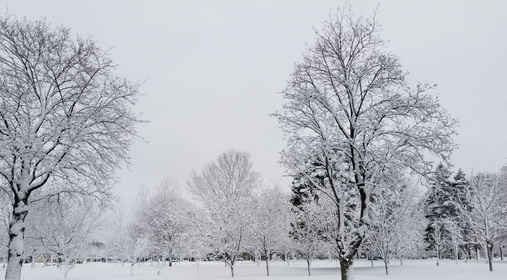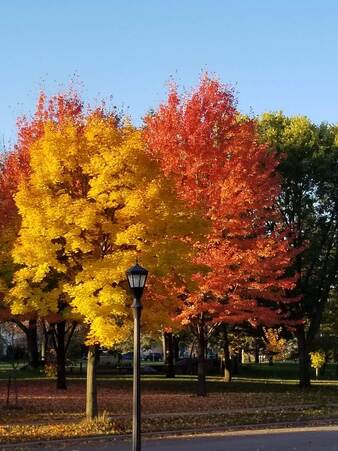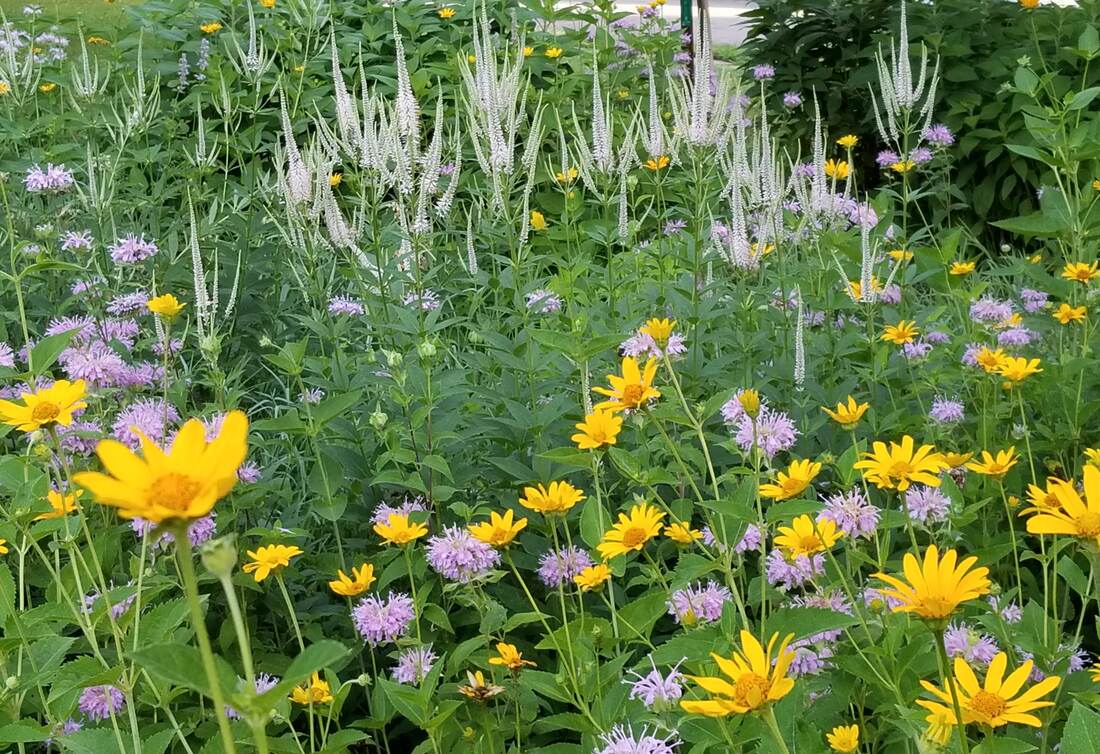Moments in Horton Park
|
Half a block from my house is a park that my children have dubbed, “the park with the trees.” Horton Park was established in the late 1970s as a “mini arboretum” to showcase some of the trees being used in city-wide reforestation efforts after St. Paul lost thousands of trees to disease epidemic. Only about two city blocks in area, it now houses over two-dozen varieties of trees, offering a rich variety of textures and hues throughout the Minnesota seasons.
The park recently updated the arboretum signage, posting new descriptive signposts near many of the trees. At the time, I could identify, in general terms, maples, oaks, birches, aspens, and not much else. I set myself the project of getting to know the trees in the park, focusing on one tree each day during my daily walks with our dog. By the end of that summer, I could identify Japanese tree lilacs, honey locust, ash, hop hornbeam, hackberry, hawthorn, and chokecherry; I could tell a white pine from a white fir, and distinguish among regal prince, bicolor, and red oaks. |
Being better acquainted with the individual trees, I began to notice how their characters changed with the seasons as summer flowed into fall and fall into winter. As winter deepened, I appreciated the subtle differences in how their bare branches stood out against the sky as our morning walks became darker and darker and the weather changed from day to day.
Near the end of the year, I started reading Patrick Rothfuss’ delightful Kingkiller Chronicles books. Rothfuss brings an astute sense of place to the world he creates, bringing settings and atmospheres to life with a few deft phrases. Beginning with its opening sentences describing, “…a silence of three parts. The most obvious part was a hollow, echoing quiet, made by things that were lacking. If there had been a wind it would have sighed through the trees, set the inn’s sign creaking on its hooks, and brushed the silence down the road like trailing autumn leaves,” his prose has a poetic sensibility, with a knack for unexpected metaphors that put the reader in the moment. Rothfuss draws on all the senses to create his world, a master of not only sight, “The sky was a featureless grey sheet of cloud that looked as if it wanted to rain but couldn’t quite work up the energy,” but also sound, “Her voice was like a portrait of her soul: wild as a fire, sharp as shattered glass, sweet and clean as clover,” and scent, “She smelled like road dust, and honey, and the smell the air holds seconds before a heavy summer rain.”
On January 6, 2016 I noticed the texture of the hard-packed snow underfoot and started contemplating how Rothfuss would describe it. During the rest of the walk with my dog and my ten-block trek to the light rail station, I rolled words around in my mind, savoring them and trying out the feel of different phrases. I rejected many and held on to some, shuffling and rearranging the chosen ones until they fell into place. By the time I arrived at the station, I had composed a sentence to capture the moment: Paths not cleared, but packed by a hundred dog walkers, create the sensation of walking on a rocky beach. Upon boarding the train, I jotted it down using the iPad I had received for Christmas.
I found the experience of noticing one particular thing and seeking a way to capture it in language quite delightful. I also appreciated that it fit so neatly into my routine, requiring no extra time, only more focused attention. So I decided to try it again. Initially skeptical that there would be something worth noticing every single day, I set a goal of a few times a week. Three days later, though, I was pleasantly surprised to find I had been able to distill a moment every day:
 Horton Park after snow. Photo by Tracy Kugler
Horton Park after snow. Photo by Tracy Kugler
Jan. 7- Predawn sky of polished tin. The pearly sheen picks out each bare twig like a delicate engraving.
Jan. 8 - Frosted with snow, treetops - so distinct yesterday - now fade into the pale sky. But when kissed by cool light become ethereal lace.
Jan. 9 - The park is ours alone, but for scattered snowmen, silent sentinels standing watch over tiny ramparts topped with twigs.
This string of daily successes brought to mind Jim Brandenburg’s “Chased by the Light” project. In the fall of 1997 (in the days before digital photography), Brandenburg, a Minnesota nature photographer, set himself the challenge of taking one single photo each day for the 90 days between the autumnal equinox and the winter solstice. My dad, a talented amateur photographer, has long admired Brandenburg’s work, and kept a copy of the resulting book on the coffee table. Being a lover of both images and words, the poetry of the title and the economy of words with which it conveyed the complex emotion of the project had always stuck with me. The exquisite photographs capture the essence of Minnesota’s North Woods in the specificity of each carefully chosen frame and the collective story they tell of the transition from activity into dormancy.
Inspired by Brandenburg’s model, I set myself a new goal of writing a “moment” each day for a year. (I’m not one to do things in half measures, and I initially misremembered the length of Brandenberg’s project. By the time I got around to actually looking it up, I was too far gone.) As most years do, 2016 brought both joys and challenges. Interestingly, save for the depths of a long stretch of flat grey late fall days, writing my Moments in the Park turned out not to be one of the challenges. Rather, the discipline of observing, noticing, and exercising my creativity to record the changing character of the trees, birds, flowers, wind and water in my neighborhood was a grounding touchstone in the tumultuousness of life.
Some days the creation of a moment would be nearly instantaneous, coming to mind fully formed at first sight. One gusty morning I walked around a corner piled with drifting snow, and the motion of it blowing and swirling brought to mind movie battle scenes of charging knights. Almost immediately, I had the moment for the day - The wind sends waves of fresh snow roiling over the crest of a hill, like the berserker charge of a ghostly army. Others required mental time and space to marinate before finding the essence of the moment. After a walk under a bridge spanning the Mississippi, it was over a week before I realized that what I wanted to capture was the tension and balance between solidity and fluidity, finally arriving at, Monumental pilings stretch sturdy and strong between traffic flowing in and out of the city above, and below, the gathering rush of water from half a continent streaming toward the ocean.
|
For most days, the moment hews closely to the original intention of conveying a specific sense of place and time. Sometimes, though, a larger commentary is layered with an observation, consciously or unconsciously. On July 6, Philando Castile was fatally shot by a police officer less than four miles from Horton Park, along the route we drive from our house to my parents’ house. The shooting rocked the community’s sense of the Twin Cities as a place of tolerance and inclusiveness and, thankfully, prompted many frank conversations and collective grappling with how to confront a national issue that had come into our own backyards. In the following weeks, wildflower gardens bloomed in front yards and boulevards. I noticed and admired them, but never quite latched on to the right aspect to capture. Finally, on July 24, I found the words to put the images and the events together. The moment for that day is dedicated to Philando: Wildflower beds are models of cosmopolitan harmony, abundant and flourishing with a diversity of purple, white, orange, and pink.
|
On a lighter note, in mid-September I was pulling together the final pieces of a large and complex grant proposal just as the semester was starting, and I was teaching for the first time in five years. On the night of the fifteenth, I came as close to pulling an all-nighter as I had since college. It wasn’t until looking back at the moments for the month that I realized the following two days both reflected my longing for sleep. September 16, Light filters through thin patches in an uneven overcast, like a nightlight through worn spots in a well-loved child's blanket. September 17, The soothing sound of water tumbling over rocks and scent of rosemary, basil, and mint wrap my senses in comfort, like snuggling into a downy quilt.
That I was able to consistently observe and record moments even during those busy weeks, and through all the other challenges of the year, is testament to the beauty of the exercise. Finding “moments in the park” (or backyard, sidewalk, or out the window of a car) requires no expensive equipment, no specialized training, and very little time, simply being attuned to and aware of the ever-changing exhibits in the gallery of our neighborhoods. I hope that you go out to look, listen, and find your own moments.
This essay originally appeared in 2017 in an online magazine published by the Coordinates Society. Unfortunately, the organization no longer exists.

